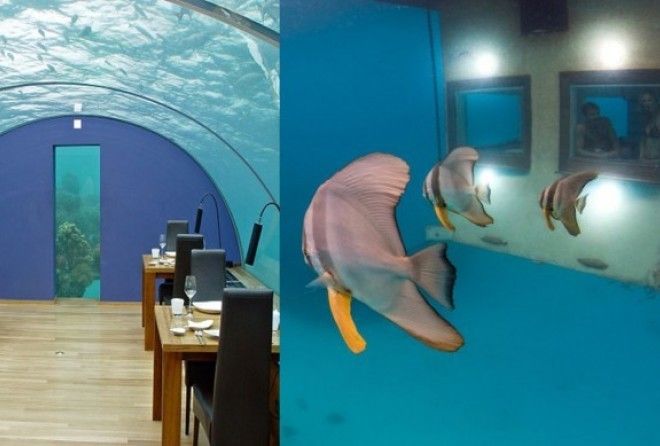Below are just some of the underwater destinations open to the public today.
1. The Atlantis, The Palm Resort, Dubai: Luxury Lagoon Suites
Nowhere does jaw-dropping luxury hotels quite like Dubai, and Atlantis, The Palm is among the best the emirate has to offer. Though not strictly an underwater hotel, the resort boasts signature suites which offer floor-to-ceiling views of the Ambassador Lagoon. Guests can view 65,000 marine animals from the comfort of their beds, or take a dive and get up close and personal.
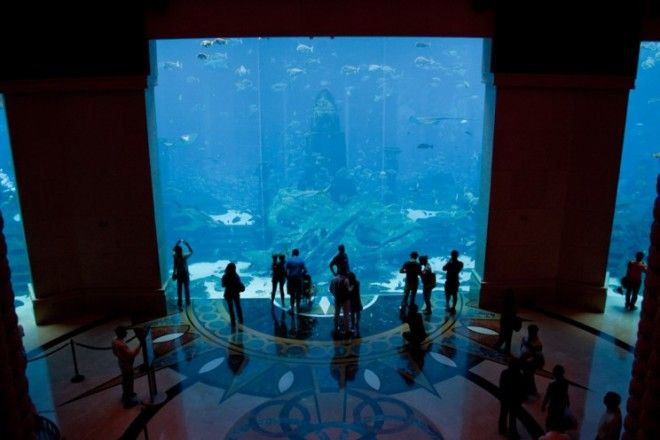
The resort was designed by acclaimed firm Wimberley, Allison, Tong and Woo, with construction taking place under the guidance of Laing O'Rourke. The resort's design embraces Arabic aesthetics and architecture, and references the legend of the lost city of Atlantis throughout.
Construction was completed in late 2008 on the man-made island of Palm Jumeirah.

2. The Utter Inn, Sweden: Scandinavian Style With An Underwater Twist
From the outside, Sweden's Utter Inn looks more like a quaint floating cottage than an underwater hotel. Upon closer inspection, however, visitors will find a cozy bedroom that stretches ten feet beneath the surface of Lake Mälaren.
The inn was designed by artist Mikael Genburg, who previously made a name for himself designing quirky hotels like Ooops, also located on Lake Mälaren. It was opened in the year 2000, and has been attracting curious travelers from around the world ever since.
On the top deck, tourists can sunbathe, or cook in the inn's compact kitchen. Below deck are two single beds, with windows on each side providing views of the local marine life. Visitors can also take a short boat ride to the uninhabited islands nearby.

3. The Ithaa Undersea Restaurant, The Maldives: The World's First Underwater Restaurant
Belonging to the Conrad Hotel Resort in the Maldives, Ithaa is submerged 16 feet (5 meters) beneath the water and is the world's first underwater restaurant. Though the Conrad itself is not an underwater hotel, the Ithaa was available to be booked for overnight stays from April 2010 to April 2011.
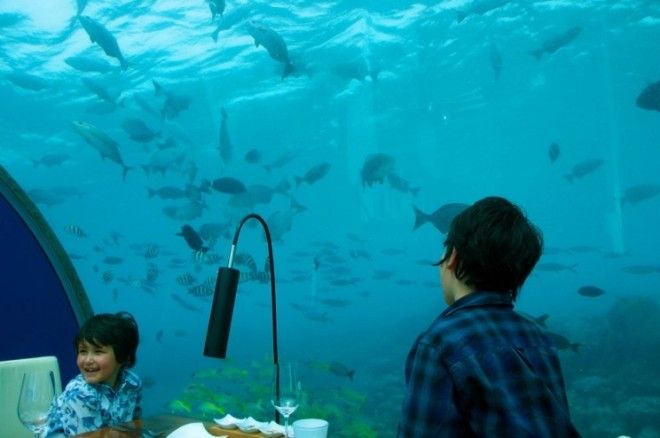
The Crown Company initially approached architect Mike Murphy of M.J Murphy Limited to create an underwater restaurant comprised of conventional walls and large, glass windows. They later agreed to Murphy's vision of housing the restaurant within a 16-by-30 foot (5-by-9 meters) acrylic tunnel, which would allow for greater visibility of the underwater surroundings.
Ithaa officially opened in April 2005, and can sit up to 14 guests.
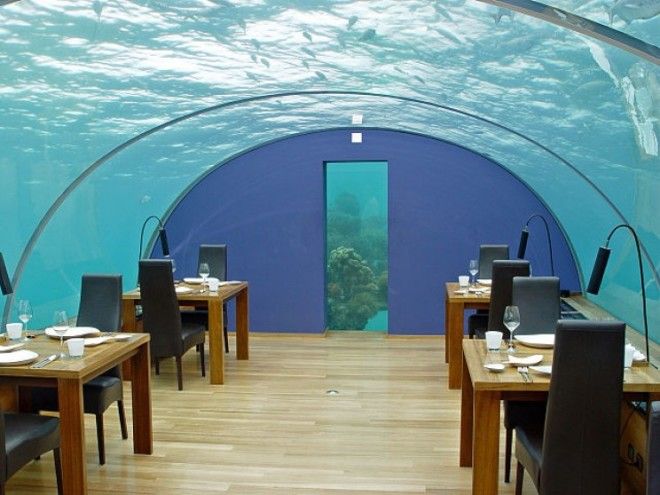
4. The Manta Resort, Tanzania: Your Own Private Floating Island
Located off the coast of Zanzibar, The Manta Resort is the ultimate underwater hotel experience for travelers who want to leave the crowds behind and explore for themselves.

Designed by Swedish company Genberg Underwater Hotels, the hotel was inspired by Sweden's Utter Inn hotel. It is comprised of three levels, the lowest of which sits 13 feet (4 meters) beneath the sea's surface. The bottom deck is also fitted with windows on each wall, allowing for 360-degree views of the marine life outside.
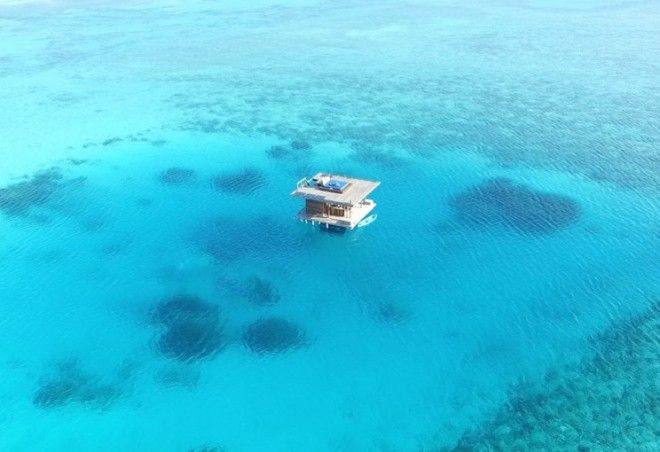
The outer walls are expected to attract coral growth, increasing the marine population in the hotel's direct vicinity. The hotel also comes equipped with underwater spotlights to attract squids, octopi, and sea slugs, as well as allow for late-night views of the sea.

Genberg Underwater Hotels hopes for the hotel to become a hub of animal life on the coast, benefitting the local ecosystem as opposed to disrupting it.
5. The Jules' Undersea Lodge, Florida, USA: The Only Underwater Hotel in America
Jules' Undersea Lodge was originally known as the La Chalupa research laboratory, an underwater facility in Key Largo, Florida used for exploring the continental shelf off the coast of Puerto Rico. For the past couple of decades, however, it has been open to intrepid explorers as an underwater hotel.
Access to the lodge is available only through scuba diving, and the staff offers scuba lessons to all first-time visitors. The entire structure sits on five feet, suspending it just atop the bottom of the lagoon. At present, it is the only underwater hotel in the United States.
Compressed air is pumped through the lodge, to prevent water from rising and flooding the structure from its open, circular entrance. The lodge comes equipped with air conditioning and internet, as well as large portholes where visitors can look out at the surrounding wildlife.
These luxury underwater lodgings usually come with a large price tag, but when you consider the work that goes into building such hotels it's easy to see why.
Building beneath the water's surface is an expensive, labor-intensive, and potentially dangerous task. Ensuring the safety of the hotel's staff and residents, as well maintaining the level of comfort one would expect from luxury accommodation, requires the talents and skills of architects and engineers at the top of their game.
It may be some time before we see a fully submerged, multi-room hotel but many exciting architectural concepts are quickly attracting investments. These new designs are seeking to address some of the most difficult obstacles towards building underwater.
Under Pressure: How Underwater Hotels Will Combat the Effects of Water Pressure
One of the biggest hurdles to overcome in the construction of an underwater hotel is the issue of water pressure. With some proposed hotels aiming to be located as much as 40 feet (12 meters) beneath the water's surface, materials that can withstand great deals of pressure, while still allowing for superb underwater views, are an absolute must.
Water pressure can have a number of adverse effects on the human body, so keeping the interior pressure of an underwater hotel as close to that of the surface is vital.
One solution is the integration of airlocks. The proposed Fiji Poseidon Resort will rely on individual airlocks at the entrance of each suite. This allows each section of the resort to maintain surface levels of pressure, lowering compression risks that come at such great depths.
Construction: The Difficulties of Building Off-Shore and Underwater
In order to reach their desirable depths, most proposed underwater hotels are set to be built off-shore. However, this naturally leads to its own issues, like the accessibility of materials and labor.
One of the more promising contemporary concepts for an underwater hotel, the Dubai Water Discus, plans on solving this issue by breaking ground in the lagoon of Kuredhivaru Island. The island is a mere 0.2 miles (300 meters) from the proposed site, and would be accessible by a wooden bridge.
Thanks to its proposed modular design, as envisioned by Deep Ocean Technology, the component parts of the hotel could be produced individually before being transported and constructed onsite.
If these proposed concepts are eventually successful, they have the potential to change how and where we build forever. The construction of these ambitious designs would be a major milestone in underwater engineering.
